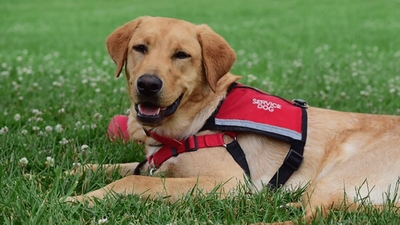Steve Kotowske
This month we will focus on Service Dog etiquette. Spring is coming soon according to Punxsutawney Phil, and we on the coast know that means a flood of visitors will be arriving to fill our favorite haunts. There is also a greater possibility of experiencing a Service Dog; and you should be prepared with the proper etiquette. Because I am a trainer, I will also address the proper behavior you should expect from the dog/handler team.

First and foremost, leave Service Dogs and their handlers alone. They don’t need your sympathy, your concern, or your comments on how beautiful their dog is. Harsh? Maybe. Your good intentions are actually counter to the proper training of a Service Dog. In fact, it can be detrimental to the health and well-being of the handler. You see, a real Service Dog is trained to assist the handler at all times with injuries or disabilities that you may or may not see. For example a person with Diabetes would need the dog to continually pay attention to the blood sugar levels of its handler as much as a person with a mobility impairment needs the dog to pay attention to its handlers balance.
Now, let’s dive into dog and handler behavior. A properly trained Service Dog should behave in public and be nearly invisible. Obviously, some dogs you see are not as well trained as others. This is due to many factors, including who trained the dog. Some people with little or no experience will train their own Service Dog. Some kindhearted people with time, a love for dogs, and a passion to help people will also attempt training. The problem is that many lack the skills necessary to properly train. There are rules governing behavior in public. A Service Dog that is unruly and cannot be brought under control can be asked to leave an establishment, according to the Americans with Disabilities Act. As the Executive Director for Pawsitive Love Foundation, there is no one more critical of a fake Service Dog. PLF provides professionally trained Service Dogs for Children with Autism and Epilepsy, as well as; Veterans with PTSD, Traumatic Brain Injury, and Military Sexual Trauma. If you encounter a suspected fake, bring it to the attention of the shop or restaurant management. They are allowed to ask 2 very important questions of the handler. First, they may ask if it is indeed a Service Dog. They may also ask what tasks the dog does to assist the handler. Those tasks must be supported through training. If you are a person who likes to take your dog everywhere with you, and do so under the guise of being a Service Dog, consider what that means to those with Service Dogs that are charged with protecting the life of their handler?
Steve Kotowske is the Executive Director for Pawsitive Love Foundation, a non-profit that places Services Dogs to Veterans and Children with a range of disabilities. For more information on Pawsitive Love Foundation visit: www.pawsitivelovefoundation.org.
The post Tips from the Trainer: Service Dog Etiquette appeared first on South Walton Life | 30A News, Events and Community Information.

Be the first to comment on "Tips from the Trainer: Service Dog Etiquette"